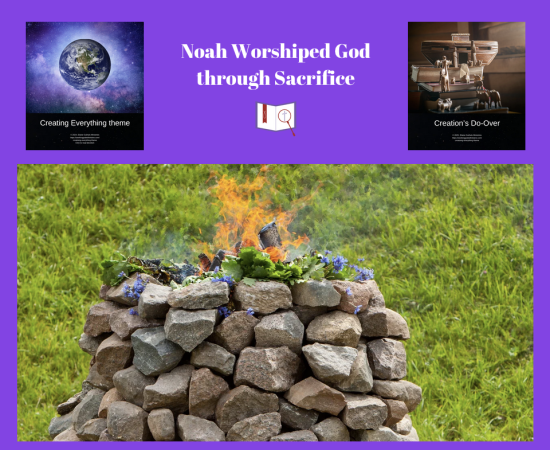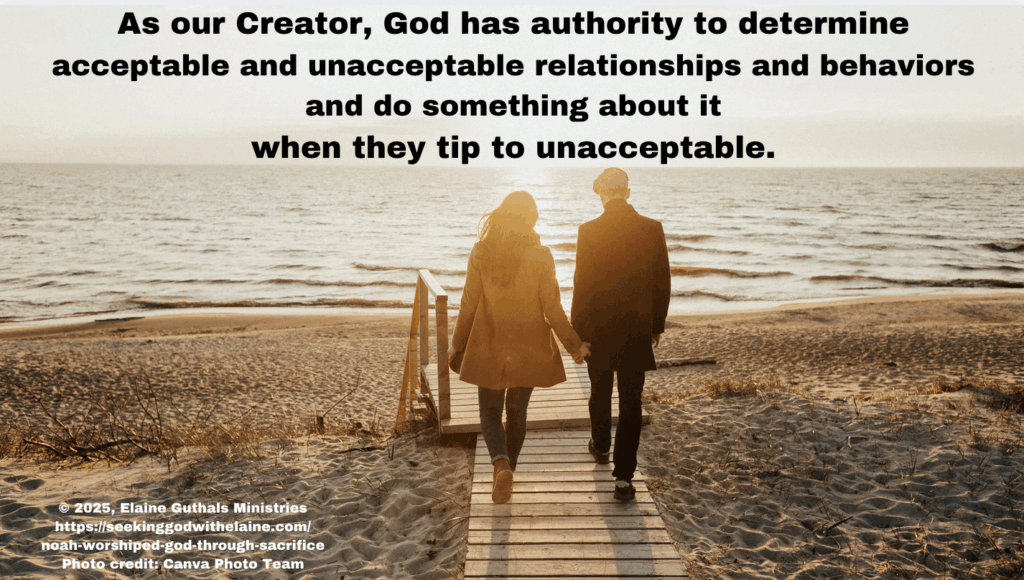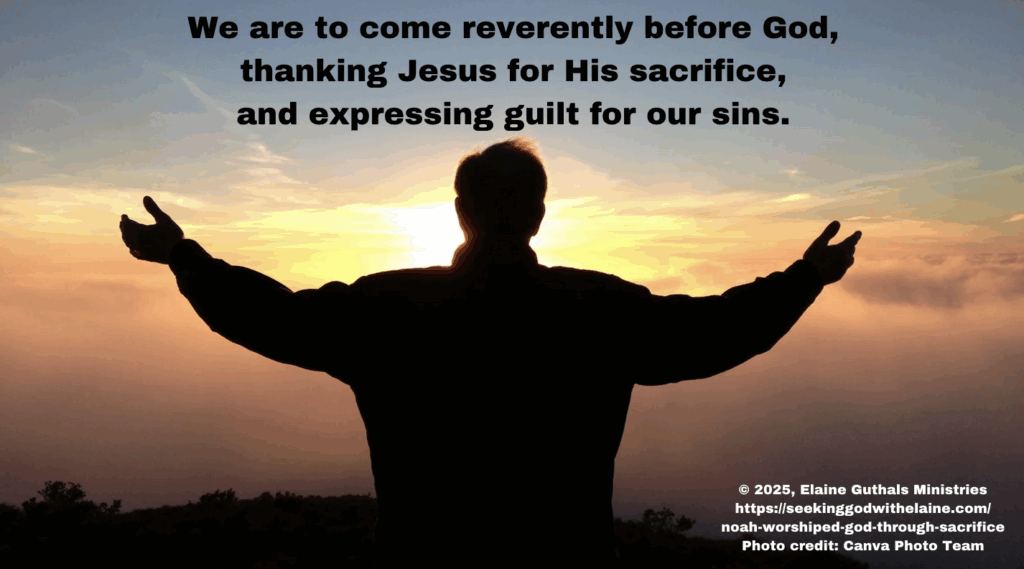Once off the ark, Noah built an altar and offered a sacrifice to God. This devotional reading looks at what that sacrifice was and why so many animals were sacrificed.
Nuggets
- Noah immediately worshiped God after he disembarked from the ark.
- Every clean animal and bird were offered to God to restore their blessing.

I wonder what the earth looked like when Noah and his family stepped off the ark. Was it a flood-ravaged land? Or did it look pure, as the Garden of Eden had?
Either way, Noah had to have been overwhelmed by gratitude that God was willing to let even a small remnant of humans remain.
God not only allowed Noah and his family to continue living, but He also made a covenant with then.
Let's Put It into Context
To read devotions in the Creating Everything theme, click the button below.
Devotions in the Creation’s Do-Over series
Let's Put It into Context #2
Covenants are agreements, contracts, or promises between two parties to perform the responsibilities listed in the covenant. The parties can either have equal standing or be between unequal parties, such as kings and subjects. When parties had unequal footing, the one in the king position would outline the protection offered through the agreement, and the subjects would pledge their loyalty to the king.
God always initiated and designed the covenants made between He and humans. This is important because it solidifies our position as recipient, not contributor. We are to accept what God offers.
While we do have free will to accept salvation and enter into a covenant with God, it is an all-inclusive covenant. Those who do not obey His covenant will be punished.
Baker’s Evangelical Dictionary of Biblical Theology noted the frequency of covenants in both the Old and the New Testaments. They wrote, “The biblical words most often translated ‘covenant’ are berit [tyir.B] in the Old Testament (appearing about 280 times) and diatheke [diaqhvkh] in the New Testament (at least 33 times).”
Resource
Fun fact. Testament is a synonym for covenant. In other word, all of God’s Word is a covenant with us.
A bond would be formed to mutually benefit both parties. Acceptance of the responsibilities of the covenant is shown by giving an oath.
There were several elements in covenants. Many included a time of fellowship centered around a meal.
Others included shedding of blood, usually an animal given as a sacrifice. A sacrifice was especially appropriate as a penance when one of the parties was offended. It was to precede a reconciliation.
Some covenants were written on stone tablets to show it was a binding covenant. Such a covenant could not be amended. Breaking the tablets would have shown its termination.
There would be provisions for rewards and punishments when the agreement was kept or broken. These blessings and cursings show that God will bless obedience and punish disobedience.
Noah Built an Altar
“Then Noah built an altar to the Lord, and there he sacrificed as burnt offerings the animals and birds that had been approved for that purpose” (Gen. 8: 20 NLT)
Noah immediately worshiped God after he disembarked from the ark.
First things first. The way it was written, it sounds like Noah – immediately after disembarking – built an altar and sacrificed to God. God didn’t tell him to do that – he just did it.
Noah was still being obedient.
Noah didn’t build his house first. He didn’t build a temple – or even designate a garden.
The burnt sacrifice Noah offered was to restore his relationship with God because of humankind’s sinful nature. (Daily animal sacrifices were need according to the Law of Moses because animal blood could not change our sinful nature. Only the blood of Jesus could do that.)
We know humans had offered sacrifices to God previously. That was what got Cain in trouble (Gen. 4: 3-7).
This was the first time that we are told the sacrifice was given on an altar. Even if Cain and Abel – along with Adam and Eve – didn’t have a physical structure for an altar, they certainly would have had a place of consecration at which to perform the sacrifice.
But God being One Who never changes and works through patterns, I think we would be safe in assuming that there had always been an altar. They may not have been as defined as they were in the Law of Moses, but I see it as a progression – altar of common material to altar in the Tabernacle to altar in the Temple.
God works through progressions, too.
Look at it this way. Noah – if we take it one way – was the only righteous man before the flood. If that was the case, his family was saved because of him.
During the long year on the ark, Noah could have thought about that and gotten prideful. He didn’t.
Immediately after getting off the ark, Noah must have felt the weight of repopulating the earth. He must have thought he was not only representing his family – who probably were right there beside him – as the priest but also every person that would come after him – including you and me.
Exell reminded us of one way in which Noah showed his righteousness. He wrote, “This sacrifice was the natural outcome of Noah’s gratitude.”
Resource
It was more than Noah was sincerely grateful to God for saving the lives of him and his family. He was acknowledging God’s sovereignty and his dependance. Noah was also pledging to continue to be obedient the rest of his life.
This sacrifice was even more than that. It was a visual exhibition of Noah’s faith. It spoke of his future atonement.
As our Creator, God has authority to determine acceptable and unacceptable relationships and behaviors and do something about it when they tip to unacceptable.

Some of Every Clean Animal and Bird
Every clean animal and bird were offered to God to restore their blessing.
I guess I had always read over this part of verse 20. I hadn’t considered that more than one animal was sacrificed.
But some of every clean animal and bird were sacrificed. That means not only on species, but also more than one of a species. (And I would say that Noah wouldn’t break up a pair, so it would be at least one or two pair.)
We think of clean animals as bulls, sheep, goats, doves, and pigeons.
- “The Lord called to Moses from the Tabernacle and said to him, ‘Give the following instructions to the people of Israel. When you present an animal as an offering to the Lord, you may take it from your herd of cattle or your flock of sheep and goats’” (Lev. 1: 1-2 NLT).
- Then the Lord said to Moses, ‘Dedicate to me every firstborn among the Israelites. The first offspring to be born, of both humans and animals, belongs to me’” (Ex. 13: 1-2 NLT).
That isn’t all. Animals for eating had to be clean, also.
- “Then the Lord said to Moses and Aaron, ‘Give the following instructions to the people of Israel. “Of all the land animals, these are the ones you may use for food. You may eat any animal that has completely split hooves and chews the cud”’” (Lev. 11: 2-3 NLT).
- “These are the animals you may eat: the ox, the sheep, the goat, the deer, the gazelle, the roe deer, the wild goat, the addax, the antelope, and the mountain sheep” (Deut. 14: 4-5 NLT).
- “Of all the marine animals, these are ones you may use for food. You may eat anything from the water if it has both fins and scales, whether taken from salt water or from streams” (Lev. 11: 9 NLT).
- “You may, however, eat winged insects that walk along the ground and have jointed legs so they can jump. The insects you are permitted to eat include all kinds of locusts, bald locusts, crickets, and grasshoppers” (Lev. 11: 21-22 NLT).
If you are interested, the Bible Study website has an extensive list on clean and unclean animals for food.
Resource
No, sacrifices didn’t always have to be to this extent. Usually, sacrifices were one per person, maybe family at the most.
There were times when multiple sacrifices were offered.
- “After the ordination ceremony, on the eighth day, Moses called together Aaron and his sons and the elders of Israel. He said to Aaron, ‘Take a young bull for a sin offering and a ram for a burnt offering, both without defects, and present them to the Lord. Then tell the Israelites, ‘Take a male goat for a sin offering, and take a calf and a lamb, both a year old and without defects, for a burnt offering. Also take a bull and a ram for a peace offering and flour moistened with olive oil for a grain offering. Present all these offerings to the Lord because the Lord will appear to you today”’” (Lev. 9: 1-4 NLT).
- “King Solomon offered a sacrifice of 22,000 cattle and 120,000 sheep and goats. And so the king and all the people dedicated the Temple of God” (2 Chron. 7: 5 NLT).
- “On the first day Nahshon son of Amminadab, leader of the tribe of Judah, presented his offering [for the dedication of the altar. His offering consisted of a silver platter weighing 3 1⁄4 pounds and a silver basin weighing 1 3⁄4 pounds (as measured by the weight of the sanctuary shekel). These were both filled with grain offerings of choice flour moistened with olive oil. He also brought a gold container weighing four ounces, which was filled with incense. He brought a young bull, a ram, and a one-year-old male lamb for a burnt offering, and a male goat for a sin offering. For a peace offering he brought two bulls, five rams, five male goats, and five one-year-old male lambs. This was the offering brought by Nahshon son of Amminadab” (Num. 7: 12-17 NLT). NOTE: Each tribe offered the exact same offering, so multiply this by 12 to get the entire offering.
Each sacrifice – regardless of the number – had to be offered in faith and gratitude and had to consist of our best. Best means unblemished, pure, or first (as in first fruits).
God had told Noah to bring seven pair of animals for sacrifice. “Take with you seven pairs — male and female — of each animal I have approved for eating and for sacrifice, and take one pair of each of the others. Also take seven pairs of every kind of bird. There must be a male and a female in each pair to ensure that all life will survive on the earth after the flood” (Gen. 7: 2-3 NLT).
I can see that Noah had to offer each pair of animals and birds to God to restore their blessing. “Then God blessed them, saying, ‘Be fruitful and multiply. Let the fish fill the seas, and let the birds multiply on the earth’” (Gen 1: 22 NLT).
But all that must not overshadow the significance of the blood. The blood of the sacrifices brought penance for humans. The sacrifice of Jesus’ blood brought salvation. God only accepts the covering of our sins by blood so that we can once again appear before Him.
Making the Connections #1
Okay. God doesn’t require us to sacrifice animals anymore. So, how are supposed to offer sacrifices?
Jesus was the Sacrifice. Instead of a lamb, He was the Pascal Lamb that shed His blood to cover our sins.
We are to come reverently before God, thanking Jesus for His sacrifice, and expressing guilt for our sins.

No, we don’t transfer our sin to an animal anymore. They are transferred to Jesus.
We do, however, have to acknowledge our sins and specifically ask forgiveness for them.
Making the Connections #2
Burton said something important.
- We are more selfish in our sacrifices than Noah was.
- We want our worship of God to be in the way that we want to give it, not necessarily as God says we should worship Him.
- We want to worship God when it doesn’t cost us anything. God doesn’t promise that.
Resource
Noah didn’t count the cost. He sacrificed a significant amount of the animals to worship God. He did it voluntarily and promptly.
Making the Connections #3
I love what Arnold said. He wrote,
“Everything is properly called good or evil according as it answers or defeats the purpose for which it was made. We were made for our Maker’s glory, after His own image, that we should make His will the rule of our lives, and His love and anger the great objects of our hope and fear; that we should live in Him, and for Him, and to Him, as our constant Guide and Master and Father. If we answer these ends, then we are good creatures; if we do not, we are bad creatures.”
Resource
We were made to worship and glorify God. Nothing else that we do makes up for not doing that.
“A good tree produces good fruit, and a bad tree produces bad fruit. A good tree can’t produce bad fruit, and a bad tree can’t produce good fruit. So every tree that does not produce good fruit is chopped down and thrown into the fire. Yes, just as you can identify a tree by its fruit, so you can identify people by their actions” (Mt. 7: 17-20 NLT).
How Do We Apply This?
- Be sure to offer our praise, worship, and sacrifices to God before, during, and after His acts of deliverance.
- Realize that we only serve God through our sacrifice.
- Express feelings of thankfulness and guilt when we offer our sacrifice.
- Worship God in the way He requires.
- Worship God voluntarily and promptly.
Resource
Father God. We so often think that only one pair of animals were taken on the ark. But there were more that were of the ones that were designated to worship and honor You. Thank You for showing us how to worship You. Amen.
What do you think?
Leave me a comment below (about this or anything else) or head over to my Facebook group for some interactive discussion.
If you don’t understand something and would like further clarification, please contact me.
If you have not signed up for the email providing the link to the devotions and the newsletter, do so below.
If God has used this devotion to speak with you, consider sharing it on social media.